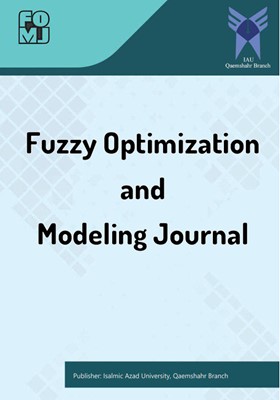A New Approach for Solving Fuzzy Single Facility Location Problem Under L1 Norm
Subject Areas : Fuzzy Optimization and Modeling JournalNemat Allah Taghi-Nezhad 1 , Fatemeh Taleshian 2
1 -
2 -
Keywords: fuzzy numbers, Single facility location problem, Demand centers, Facility centers,
Abstract :
The location allocation problem is one of the most attractive optimization problems that is widely used in the real world. Therefore, any attempt to bring this problem closer to real-world conditions would be significant and useful. In this paper, we utilize fuzzy logic due to the uncertainty of parameters in the real world. That is the weights (the amounts of demands of customers) and variables (the coordinates of the optimal place) are both considered fuzzy numbers. If these variables are considered definitively, due to various conditions and reasons, it may not be possible to acquire land or build a facility center in it, so we also considered this variable in a fuzzy way and a facility center area was obtained, that certainly, the decision maker can find the right place more easily. To solve the fuzzy problem a new approach based on presenting the problem in the form of equivalent expressions is proposed. This equivalent problem is solved using fuzzy arithmetic.
1. Aider, M., Dey, I., & Hifi, M. (2023). A hybrid population-based algorithm for solving the fuzzy capacitated maximal covering location problem. Computers & Industrial Engineering, 108982.
2. Altay, G., Akyüz, M. H., & Öncan, T. (2023). Solving a minisum single facility location problem in three regions with different norms. Annals of Operations Research, 321(1-2), 1-37.
3. Atta, S., Mahapatra, P. R. S., & Mukhopadhyay, A. (2022). Solving a new variant of the capacitated maximal covering location problem with fuzzy coverage area using metaheuristic approaches. Computers & Industrial Engineering, 170, 108315.
4. Bazaraa, M. S., Jarvis, J. J., & Sherali, H. D. (2011). Linear programming and network flows: John Wiley & Sons.
5. Bector, C., & Chandra, S. (2005). Fuzzy mathematical programming and fuzzy matrix games (Vol. 169): Springer.
6. Brimberg, J., Hansen, P., Mladenovic, N., & Salhi, S. (2008). A Survey of Solution Methods for the Continuous Location-Allocation Problem. International Journal of Operations Research, 5(1), 1-12.
7. Esmikhani, S., Kazemipoor, H., Sobhani, F. M., & Molana, S. M. H. (2022). Solving fuzzy robust facility layout problem equipped with cranes using MPS algorithm and modified NSGA-II. Expert Systems with Applications, 210, 118402.
8. Eydi, A., & Shirinbayan, P. (2023). Multi-modal and multi-product hierarchical hub location problem with fuzzy demands. Engineering Applications of Artificial Intelligence, 123, 106282.
9. Karagöz, S., Deveci, M., Simic, V., & Aydin, N. (2021). Interval type-2 Fuzzy ARAS method for recycling facility location problems. Applied Soft Computing, 102, 107107.
10. Kulkarni, C., Talib, M., & Jahagirdar, R. (2013). Simulation methodology for facility layout problems. The International Journal of Engineering, 2(2), 24-30.
11. Lee, K. H. (2004). First course on fuzzy theory and applications (Vol. 27): Springer Science & Business Media.
12. Love, R. F., Morris, J. G., & Wesolowsky, G. O. (1988). Facilities location.
13. Omidi, S., & Fathali, J. (2022). Inverse single facility location problem on a tree with balancing on the distance of server to clients. Journal of Industrial and Management Optimization, 18(2), 1247-1259.
14. Ortega, J., Tóth, J., Moslem, S., Péter, T., & Duleba, S. (2020). An integrated approach of analytic hierarchy process and triangular fuzzy sets for analyzing the park-and-ride facility location problem. Symmetry, 12(8), 1225.
15. Rath, S., & Chow, J. Y. (2022). Air taxi skyport location problem with single-allocation choice-constrained elastic demand for airport access. Journal of Air Transport Management, 105, 102294.
16. Ryu, J., & Park, S. (2022). A branch-and-price algorithm for the robust single-source capacitated facility location problem under demand uncertainty. EURO Journal on Transportation and Logistics, 11, 100069.
17. Taghi-nezhad, N., Naseri, H., Khalili Goodarzi, F., & Taleshian Jelodar, F. (2015). Reactive scheduling presentation for an open shop problem focused on jobs’ due dates. Journal of Production and Operations Management, 6(2), 95-112.
18. Taghi-Nezhad, N. A. (2019). The p-median problem in fuzzy environment: proving fuzzy vertex optimality theorem and its application. Soft Computing, 23(22), 11399-11407.
19. Taghi-Nezhad, N. A. (2022). A revisit of the proposed model for solving fuzzy linear fractional programming problem. International Journal of Mathematics in Operational Research, 23(2), 215-231.
20. Taghi-Nezhad, N. A. (2023). Fuzzy linear fractional programming for container transportation optimization. Iranian Journal of Marine Science and Technology. doi: 10.22034/ijmst.2023.544120.1636
21. Taghi-Nezhad, N. A., Moradi, S., & Karamali, G. (2021). Fuzzy facility location problem with point and rectangular destinations. International Journal of Mathematics in Operational Research, 18(1), 21-44.
22. Taleshian, F., & Fathali, J. (2016). A mathematical model for fuzzy-median problem with fuzzy weights and variables. Advances in Operations Research, 2016.
23. Taleshian, F., Fathali, J., & Taghi-Nezhad, N. A. (2022). Finding the absolute and vertex center of a fuzzy tree. Transportation Letters, 14(6), 591-599.
24. Taleshian, F., Fathali, J., & Taghi-Nezhad, N. A. (2018). Fuzzy majority algorithms for the 1-median and 2-median problems on a fuzzy tree. Fuzzy Information and Engineering, 10(2), 1-24.
25. Varnamkhasti, M. J. (2012). Overview of the algorithms for solving the P-median facility location problems. Advanced Studies in Biology, 4(2), 49–55.
26. Xu, J., & Song, X. (2015). Multi-objective dynamic layout problem for temporary construction facilities with unequal-area departments under fuzzy random environment. Knowledge-Based Systems, 81, 30-45.
27. Zha, S., Guo, Y., Huang, S., Wu, Q., & Tang, P. (2020). A hybrid optimization approach for unequal-sized dynamic facility layout problems under fuzzy random demands. Proceedings of the Institution of Mechanical Engineers, Part B: Journal of Engineering Manufacture, 234(3), 382-399.


